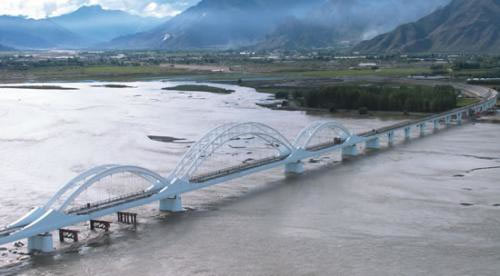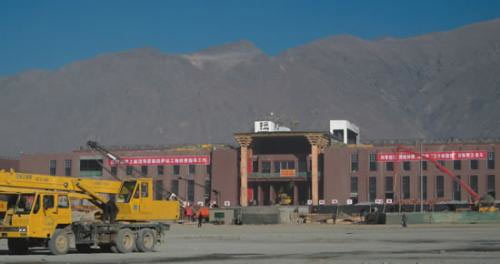
Lhasa railway station, January 2006.
New images of the railroad development obtained by ICT show the new station in Lhasa as well as depicting early indicators of the environmental impact of the 33 billion yuan ($4 billion) project, which has been prioritized by the Chinese authorities as a key element of the PRC’s drive to develop the Western regions, including Tibetan areas.

An image of the new railway bridge on the Kyichu River in the Toelong Dechen area in the western area of Lhasa.
Statements in the English-language Chinese media over the past three months have warned that rising temperatures on the Qinghai-Tibet plateau are likely to lead to melting permafrost and an increase in the instability of the ground, threatening the viability of the railway in just a decade’s time. The impact of thawing permafrost on the plateau was first reported in the Chinese press last year, but it was estimated then that the railway would be threatened only after 45 years (see the Congressional Executive Commission on China report, Thawing permafrost may threaten Qinghai-Tibet railroad in 10 years). But on January 22, Professor Wu Ziwang, a senior expert at the Chinese Academy of Sciences’ ‘frozen soil laboratory’, was quoted as saying: “Due to the melting permafrost, I am worried that after 10 years the railroad will be unsafe” (Chinese-language report, Beijing News). In a Xinhua article on February 5, Professor Wu said: “Fast thawing of frozen soil in the plateau might greatly increase the instability of the ground, causing more grave geological problems in the frozen soil areas where major projects such as highways or railways run through…The changes could threaten the railway in a decade.”
Approximately 550 kilometers of the Qinghai-TAR railroad track (about 300 miles) runs on frozen earth. Deputy Director General La Youyu of the railroad project headquarters says: “Frozen earth is vulnerable to climate change, which will thaw in summer and distend the railway base in winter” (Xinhuanet, August 24, 2005). La Youyu was speaking following the laying of tracks at 5,072 meters above sea level in the Tibetan area of Amdo last year – 255 meters higher than the record of world railway altitude previously held by Peru at 4,817 meters above sea level in the Andes. The authorities have reported on various efforts to ward off the effect from frozen soil shrinkage, including ventilation conduits that have been built beneath the roadbed of one section of the railroad (Xinhua, February 6, 2006).
The Chinese press reported in December that the railroad would begin a full-route trial operation for commercial passenger transportation in July 2006, six months earlier than expected, and that cargo transportation was available from March onwards. It is not known whether the new awareness of the consequences of thawing permafrost was linked to the advance in construction of the railroad. Xinhua reported on April 15, 2006 that the Golmud-Lhasa section of the railway will start unmanned test runs from May 1.

The new Lhasa station, winter 2006. The slogans on each side of the fa?ade read (left to right): “A warm welcome to the high leaders arrived at the Lhasa Station construction site to inspect and direct the works” and “Scientific organization and united struggle for the achievements in the hard struggle aimed at the ‘three classes'”.
Further reports in the Chinese media this month refer to the consequences of warming of the Tibetan plateau. A senior engineer from the TAR was reported by Xinhua as saying that the phenomena of water springing from dry areas and the flooding of lakes in Nagchu (Chinese: Naqu) prefecture is caused by global warming (Xinhua, April 11). The same report says that the occurrences date back to 2000, which coincides with the first announcements of the construction of the railway.
A China Tibet Information Center report on April 12 announced that: “A large scale TV activity ‘Tibet Travel’ was launched by Shanghai Media Group to record the history of first train entering Tibet through Qinghai-Tibet Railway and cover the important event that China establishes a ‘sky railway’.” It is likely that foreign reporters will also be invited to cover the opening ceremonies.
The impact of Lhasa’s new railroad station: village relocated, river course narrowed
The new railway station complex lies on the southern banks of the Lhasa Kyichu river on the site of the former rural village Ne’eu (Chinese: Liuwu), which was demolished to make way for the development, and all the villagers relocated in a brand new village one kilometer south of its original location. Ne’eu was previously a traditional village of mud and stone houses with large courtyards (see pictures here). In January, work units were setting down the rail tracks entering the station area, while building was still in progress inside the station area. The slogans on each side of the railway station fa?ade read “A warm welcome to the high leaders arrived at the Lhasa Station construction site to inspect and direct the works” and “Scientific organization and united struggle for the achievements in the hard struggle aimed at the ‘three classes'”.

Work in progress on the bridge over the Kyichu River, to carry the road connecting the Chindrol Lam (Peaceful Liberation Road) with Lhasa station, January 2006.
The Golmud-Lhasa railway has been described by the Chinese press as the ‘centerpiece of China’s ongoing “develop the West” program’ (China Daily, December 2004). Beijing’s campaign to develop the PRC’s western regions, including the Tibetan autonomous areas, is a high-profile political campaign, initiated by the then Party Secretary and President Jiang Zemin in 1999. The leadership has continued to be involved in promoting Western development at the highest level – in February last year China’s Party Secretary and President Hu Jintao stressed the “necessity to persistently apply the scientific concept of development to direct work in order to unswervingly push forward the large-scale development of the Western region”, also stating that the Party must “accelerate the building of infrastructure facilities” (Xinhua in Chinese, February 5 2005). At a dinner at the Chinese Embassy last night (April 20, 2006) in Washington, DC, visiting President Hu Jintao again referred to the importance of this campaign.
The Lhasa landscape is being restructured in preparation for the railroad. The Chingdrol Kyil Road (Chinese: Jinzhu xilu) has been enlarged, and two ring roads connecting the Ne’eu train station area with central Lhasa are now nearly complete. The image above depicts work in progress of a bridge for cars over the Kyichu river in January, which will connect the Chindrol Lam (Peaceful Liberation Road) with Lhasa station. This bridge is in addition to the railroad bridge connecting Toelung Dechen county (Duilongdeqing) with the Ne’eu area. Eyewitness reports indicate that in order to support the road bridge, construction workers had to alter and reinforce the banks of the river in certain areas, which has had the effect of narrowing the river channel and according to observers may exacerbate the risk of flooding later.

Workers toil on the tracks of the Lhasa railway near the station.
A slogan near the main construction site reads: ‘The construction of the great Liuwu bridge will accelerate national unity’. Western development strategies in Tibetan areas are carried out according to the Party’s political and economic priorities and in order to accelerate the further integration of these areas into the rest of the PRC.
Although Party officials previously rejected reports that the construction of the railroad would be likely to increase the influx of Chinese migrants into Tibetan areas, last year an official report acknowledged that the development would “attract tourists, traders and ethnic Chinese settlers” to the Tibet Autonomous Region (China Daily, October 15, 2005). The Congressional-Executive Commission on China points to the Inner Mongolia Autonomous Region as a precedent: ‘Railroads there were built decades ago, and ethnic Han now outnumber ethnic Mongols by more than five to one”. The extension of the railroad in the Xinjiang Uyghur Autonomous Region (East Turkestan) from Urumqi to Kashgar has led to increasing numbers of Chinese migrants arriving in the oasis city and further marginalization of the Uyghur population.

The sign, near Ne’eu (Liuwu) bridge, means: ‘Making Liuwu bridge to promote unity among the ethnicities’.

The newly widened road between the Potala Palace, the Dalai Lama’s former winter residence, and the new Potala Square, Lhasa. The tall white statue in the far right is a monument placed in the square by the authorities to commemorate the ‘peaceful liberation’ of Tibet.

The newly widened road between the Potala Palace, the Dalai Lama’s former winter residence, and the new Potala Square, Lhasa. The tall white statue in the far right is a monument placed in the square by the authorities to commemorate the ‘peaceful liberation’ of Tibet.
You can find this report as a PDF document here »

